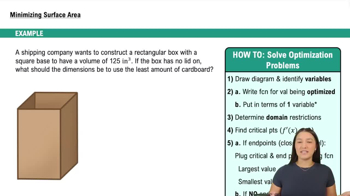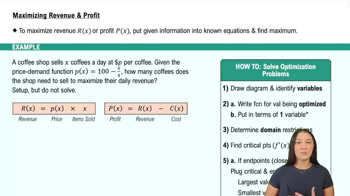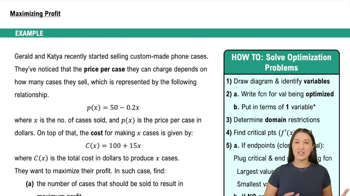Table of contents
- 0. Functions7h 52m
- Introduction to Functions16m
- Piecewise Functions10m
- Properties of Functions9m
- Common Functions1h 8m
- Transformations5m
- Combining Functions27m
- Exponent rules32m
- Exponential Functions28m
- Logarithmic Functions24m
- Properties of Logarithms34m
- Exponential & Logarithmic Equations35m
- Introduction to Trigonometric Functions38m
- Graphs of Trigonometric Functions44m
- Trigonometric Identities47m
- Inverse Trigonometric Functions48m
- 1. Limits and Continuity2h 2m
- 2. Intro to Derivatives1h 33m
- 3. Techniques of Differentiation3h 18m
- 4. Applications of Derivatives2h 38m
- 5. Graphical Applications of Derivatives6h 2m
- 6. Derivatives of Inverse, Exponential, & Logarithmic Functions2h 37m
- 7. Antiderivatives & Indefinite Integrals1h 26m
- 8. Definite Integrals3h 25m
5. Graphical Applications of Derivatives
Applied Optimization
Problem 49b
Textbook Question
Travel costs A simple model for travel costs involves the cost of gasoline and the cost of a driver. Specifically, assume gasoline costs $p/gallon and the vehicle gets g miles per gallon. Also assume the driver earns $w/hour.
b. At what speed does the gas mileage function have its maximum?
 Verified step by step guidance
Verified step by step guidance1
Identify the relationship between speed, gas mileage, and time. The gas mileage function typically decreases as speed increases beyond a certain point due to increased air resistance and engine efficiency changes.
Express the gas mileage function, g(v), in terms of speed v. This function will likely be a quadratic or similar function that models how gas mileage changes with speed.
Determine the critical points of the gas mileage function by taking the derivative of g(v) with respect to v and setting it equal to zero, g'(v) = 0.
Analyze the second derivative, g''(v), to confirm whether the critical points found are maxima or minima. A negative second derivative indicates a maximum.
Solve for the speed v at which the gas mileage function reaches its maximum by substituting the critical points back into the original gas mileage function.
Was this helpful?

 1:13m
1:13mWatch next
Master Intro to Applied Optimization: Maximizing Area with a bite sized video explanation from Callie
Start learningRelated Videos
Related Practice









